#in a list of near threatened species
Text
Ensure protection and multiplication of surviving animals.

The survey was organized by IUCN jointly in collaboration with Balochistan Forest & Wildlife Department and SUSG-CAsia Habitat & Species Conservation Project, Quetta. Five teams comprising of wildlife experts from IUCN, Balochistan Forest & Wildlife Department, SUSG-CAsia and local community members conducted this survey at various potential sites of Markhor in the area.
The survey has revealed existence of very thin population of Suleman Markhor in the Khalifat mountain range in Ziarat. During the survey, six females and one male Markhor were directly sighted in Khalifat mountain area whereas; two females were sighted in Malikat Mountains. The fresh droppings of Markhor in the Malikat mountains also confirmed existence of Markhor in the area.
Speaking on the occasion, Mr. Ghulam Qadir Shah, Project Manager Juniper Conservation Project termed the survey a great success, as existence of Suleman Makhor was scientifically authenticated in the area for the first time. According to IUCN Red List of Threatened Species, 2010, no reliable information on occurrence of Suleman Markhor in Juniper Wildlife Sanctuary Ziarat has been reported before.
He further informed that IUCN Ziarat has planned more similar surveys of the area next year to estimate total surviving population of Suleman Markhor in the area. A participatory wildlife conservation plan will also be developed and implemented in collaboration with the Balochistan Forest & Wildlife Department and local communities to ensure protection and multiplication of surviving animals. At a later stage trophy hunting of Markhor can be introduced once its population has been stabilized to promote conservation benefits for the local communities.
Mr. Shah appreciated the support provided by Balochistan Forest & Wildlife Department, SUSG and local community members in the successful completion of the survey.
Speaking on the occasion Mr. Akhtar Hussain Bazai, Conservator of Wildlife, Balochistan Forest & Wildlife Department and Mr. Tahir Rasheed National Project Manager, SUSG-Habitat and Species Conservation Project, Quetta viewed this survey as a remarkable achievement and assured their full cooperation in conservation initiatives in the future.
Suleman Markhor is the national mammal of Pakistan, which has been listed as an endangered specie in the IUCN Red List of Threatened Species. It is scattered in northeastern Afghanistan, northern India (southwest Jammu and Kashmir), northern and central Pakistan, southern Tajikistan and southern Uzbekistan. It is found in mountain ranges at the elevation from 600 to 3,600 meters. Habitat fragmentation, illegal hunting, and other anthropogenic threats have severely reduced Markhor population in its natural habitats.
#straight horned markhor#markhor#markhor conservation#iucn red list#convention on international trade in endangered species of wild fauna and flora#Malikat mountains#near threatened#surveys#habitat loss#natural habitat#reduced Markhor population#mountain ranges#south asia
0 notes
Text
Oh speaking of the Red List: saiga and scimitar-horned oryxes are no longer critically endangered! The IUCN recently updated its Red List of Threatened Species; they're now listed as Near Threatened and Endangered respectively.
1K notes
·
View notes
Text
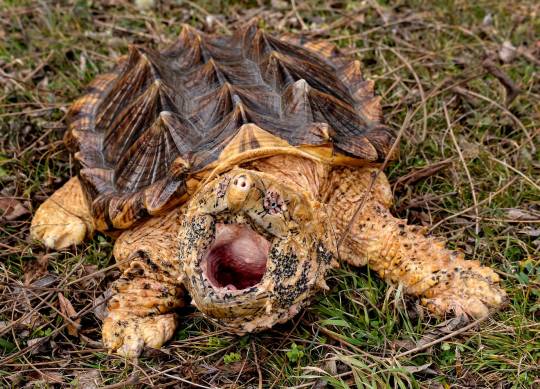


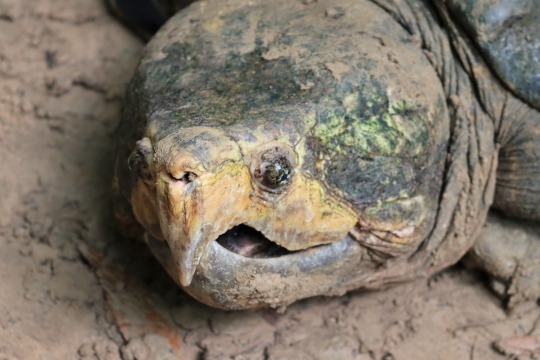
The Stupendous Alligator Snapping Turtle
Alligator snapping turtles (Macrochelys temminkii) are one of three recognised species of snapping turtle, all of which are found in North America. This particular species is found in the southeastern United States and the Mississippi Basin in particular. Macrochelys temminkii prefers deep freshwater, and is especially common in deep rivers, wetlands, and lakes.
The alligator snapping turtle is the largest freshwater turtle in North America, and is one of the heaviest in the world. Most individuals weigh between 70-80 kg (154-176 lbs), and are about 79-101 cm (31-39 in) long. However, the largest verified indiviual weighed over 113 kg (249 lb), and many others have been recorded in excess of 100 kg. The species is easily identifiable by its large, boxy head and thick shell with three rows of raised spikes. Typical alligator snapping urtles are solid black, brown, or olive green, though the shells of many older individuals can be covered in green algae.
M. temminkii is famous for its strong bite, which is most often utilised when feeding. The turtle's tongue resembles a worm, and at night individuals lie on the bottom of the river or lake bed with their mouths open. Fish are enticed by the bait-tongue, and when they get close enough the alligator snapping turtle's mouth clamps down around them. In addition to fish, this species may also feed on amphibians, invertebrates, small mammals, water birds, other turtles, and even juvenile alligators where their territories overlap. The alligator snapping turtle's relies on ambush techniques, and so hunters can remain submerged for up to 40 minutes. In some cases, individuals can also 'taste' the water to detect neaby mud and musk turtles. Because of this species' thick shell and ferocious bite, adults have few predators, but eggs and hatchlings may fall prey to raccoons, predatory fish, and large birds.
This species spends most of its time in the water, only emerging to nest or find a new home if their current habitat becomes unsuitable. Mating occurs between Februrary and May, starting later in the northern regions of the species' range. Males and females seek each other out, but generally don't travel great distances. About two months after mating, females dig a nest near a body of water and deposit between 10-50 eggs. Incubation takes up to 140 days, and the average temperature of the nest determines the sex of the hatchings; the hotter it is, the more males are produced. In the fall, hatchings emerge and are left to fend for themselves. Sexual maturity is reached at between 11 and 13 years of age, and individuals can live as old as 45 years in the wild.
Conservation status: The alligator snapping turtle is listed as Vulnerable by the IUCN. The species is threatened by overharvesting for meat and for the pet trade, and by habitat destruction.
If you like what I do, consider leaving a tip or buying me a ko-fi!
Photos
Ed Godfrey
Cindy Hayes
Eva Kwiatek
Nathan Patee
#alligator snapping turtle#Testudines#Chelydridae#snapping turtles#freshwater turtles#reptiles#freshwater fauna#freshwater reptiles#lakes#lake reptiles#wetlands#wetland reptiles#rivers#river reptiles#north america#southern north america#animal facts#biology#zoology
455 notes
·
View notes
Text

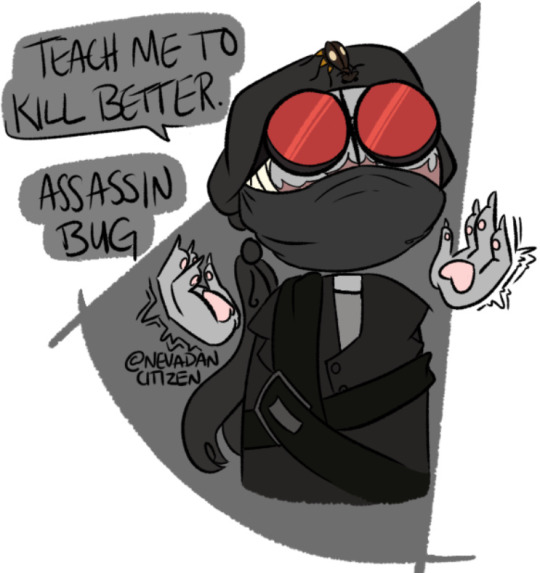
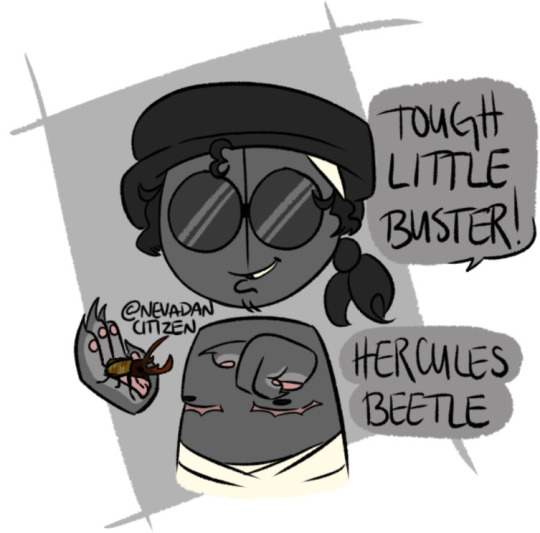

moved house recently and the movers literally destroyed my insect display case and the specimens inside so i drew the sillies with the insects i think would represent them best to soothe the pain. explanation below the cut (be warned, it’s long and so so fucking nerdy)
(+ sanford bombardier beetle follow-up)
okay so first is doc with a madagascar hissing cockroach. despite cultural connotations, cockroaches are some of the smartest insects (up there with bees, wasps, and termites (which they share an order with — blattodea)), and doc is nothing if not the brains of SQ. madagascar hissing cockroaches are some of the few insects that stay with their offspring for a long while, therefore protecting them. doc is also protective of his men in a somewhat similar fashion, albeit from a distance and behind a cold, stern demeanor. also these roaches can’t fly, and doc can’t drive. there’s a joke in there somewhere but i can’t find it.
then we’ve got hank with an assassin bug. there’s not really any notable species within the family, so it’s just supposed to be a general insect within reduviidae (but not an ectoparasite). some assassin bugs transmit chagas disease, which is mostly always unwanted and detrimental, much like hank’s presence to anyone outside of SQ (or within the SQ, because hank’s loyalty mostly just faults to his own bloodlust). assassin bugs also have one of the most painful insect bites but, unlike hank, they use chemicals (injected via proboscis) to induce pain rather than ripping and tearing. still, the end result is the same.
obviously, what else would sanford have other than a hercules beetle? they’re one of the strongest insects (as evidenced by the horns on their head and prothorax), and sanford is, unarguably, the strongest grunt of the SQ. male hercules beetles use their horns to grapple and fight (both for territory and mates), and sanford also uses very melee-heavy tactics while fighting. they also use their horns to leverage and throw their opponents, and sanford uses his hook with similar tactics. these beetles are very hardy (due to their exoskeleton and hardened elytra) just like sanford, despite his usual lack of clothing and armor.
lastly, there’s deimos and the australian tiger beetle. they’re known as the fastest species of tiger beetle (up to 9 km/h or 5.6 mph) and — not sure if this is canon or a universally accepted headcanon — deimos is the fastest grunt of the SQ. these beetles run so fast and hunt so aggressively that their sensory system literally can’t keep up and their eyes shut off, so they have to stop often (for just a fraction of a second) to regain their faculties, which gives their prey several chances to escape. this reflects in deimos through his jokey demeanor and tendency to not take things seriously until it’s too late. thankfully, the australian tiger beetle is only listed as “near threatened” on the red list, unlike deimos, who is totally fucking dead.
thank you for coming to my ted talk which is just me smushing my two special interests together like a child mixing play-doh
#riptide’s drawings ✏️#madness combat 🆘#also peek at doc’s filed-down claws i really like that little detail#madcom#madness combat#madness combat deimos#madness combat sanford#madness combat hank#madness combat 2bdamned#madness combat doc#deimos#sanford#hank j wimbleton#2bdamned#madcom deimos#madcom sanford#madcom hank#madcom 2bdamned#madcom doc#madness: project nexus#project nexus
125 notes
·
View notes
Text

For the first day of the 30 Days of Weevils challenge started by @the-named-anon, I illustrated the spectacular Giraffe Weevil (Trachelophorus giraffa)!
With such a long neck, it's not hard to see why this weevil earned its namesake! Males typically have necks that are over twice the length of their female counterparts. Like others of their family (Attelabidae), their long neck is thought to assist in building nests or fighting rivals. This tiny species is endemic to Madagascar, with its conservation status listed as Near Threatened.
Reference images: male (right), female (left).
#30daysofweevils#30 days of weevils#weevils#giraffe weevil#art challenge#illustration#scientific illustration#entomology
185 notes
·
View notes
Text
DYK…

sandbar shark have a large first dorsal fin, large pectoral fins and a mid-dorsal ridge. like many other shark species, sandbar sharks give birth to live young.
sandbar shark are named for the sandy flats, bays and estuaries where it's found. In fact, it's the most common species of shark in the Chesapeake Bay!
sandbar sharks are believed to live more than 30 years. Although sandbar sharks are listed by the IUCN Red List as only Lower Risk/near threatened, they are severely overfished in the western North Atlantic.
#sea creatures#marine life#shark#marine biology#sea#sharks#water#sealife#ocean#aquatic#ocean life#marine animals#sea life#sandbar shark#aquarium#i like sharks (and getou’s balls)
104 notes
·
View notes
Text
Palo santo 101
Before you click play on the audio recording and blithely ignore the written guide, be sure to review the important science-based charts and insight-rich visuals sprinkled throughout it.
If you’ve ever walked into a party hosted by someone under 40 in Brooklyn, Lisbon, California, Condesa or Roma Norte, or Venice Beach and not smelled palo santo, then you probably had covid. Over the past decade palo santo has become the official scent of good vibes. It is an olfactory assurance for anyone who recognizes the scent that conversation will be limited to polyamory, regional burns, and adaptogen supplements. Despite the fact that no one ever doesn’t want to smell palo santo, it’s important to know when to use it and when to relegate your surroundings to their default odor. This guide will ensure that you know exactly how to make the most of the palo santo you carry in the shoulder bag you purchased at the Sant Jordi flea market in Ibiza during the off-season.
Like most cultural appropriations, no one who burns palo santo knows what it is, where it came from, why they use it, or why it’s even called palo santo. Let’s uncover the facts.

Bursera Graveolens is a tree native to the dry tropical forests of South America. Its discovery by white people dates back to 1972 at a now defunct swingers resort in Quito, Ecuador, where a guest from New Jersey named Paulo Santonicola noticed a stick with a burning ember on the end of giving off a fetid, wispy trail of smoke. He pointed at the burning stick and asked the guy holding the cocaine tray, who would now be called a consent educator, “por que?”
“Plaga,” he replied, and gnashed his teeth and made a flapping-wing motion with the hand not holding the cocaine tray. Paulo brought the wood back to his central New Jersey home as a last-ditch effort to ward off the deer that were eating the tomatoes in his garden. He started burning the wood around the clock in the steamy summer of 1972, during which he and his girlfriend hosted dozens of play parties.
“I didn’t care if people at my parties had a problem with the smell,” recounted Paulo. “Those frickin’ deer were jumping my fence and chewing through wire to eat my tomatoes. When I caught a whiff of that wood down in Quito, I thought, ‘they won’t come near my garden if I burn this shit.’”

Mr. Santonicola had achieved some level of notoriety in the adult film industry in the early 1970s, and his parties were well attended by neo-hippies, the disco elite and the first generation of yoga professionals. Over the course of the summer, a pavlovian association formed between the scent of the wood and casual sex, and his friends started asking him for sticks so that they could take the vibe home with them. At the sunset of his porn career, he saw an opportunity not only to rebrand his legacy, distancing himself from grainy adult films with problematic titles, but also to make oceans of cash: import the wood and sell it through his readymade network of yoga instructors under his stage name, Palo Santo.
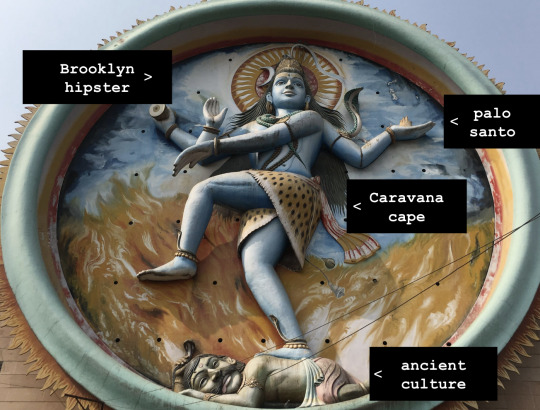
Palo santo’s ubiquity today grew from its two foundational use cases: repelling pests and masking the odor of too many naked bodies in poorly ventilated New Jersey basements. Palo santo is still used today as a repellent of sorts to ward off bad vibes and people who do not use the word vibe in place of most nouns at the end of a question, such as scene, weather, temperature, culture, menu, rules, culture, law, opinion, suggested attire, relationship status, sexual proclivity, net worth and so on. It is also still used during group sex, but only when the group sex is intentional and/or ceremonial. There are many other ways, however, that you can improve the vibes of the world through the smoke of this wood, which was recently added to IUCN’s Red List of “near threatened” species, making it even more important to burn palo santo as a way of calling attention to its growing scarcity.

Airplanes
For a brief, blissful period during the pandemic, the only people who traveled were intrepid hipsters who had already contracted the virus and been instrumental in scaling it to global significance through music festivals, long-distance polycules and global nomadism. Commercial airlines from the spring of 2020 through the summer of 2021 were basically private air travel for people who know to always ask if party buffet chocolate is psycho-active. Air travel today is a much lower vibration experience, and it’s important that assertive restorative steps be taken by conscious travelers to make flying chill again. Hanging a dreamcatcher from the back of the seat in front of you and burning palo santo on the tray table is a great way of making a public flight experience feel more private. Be sure to light your palo santo only after the aircraft reaches cruising altitude, because tray tables must be stowed until then.

Other people’s parties
Not everyone with whom you may socialize is aware of how critical palo santo is to creating and maintaining a vibe. Some less experienced hosts try to make do with incense from India, Japan or other countries that have been annexed by Brooklyn or with candles from La Labo, and it may be up to you to rescue the vibe. Back when people consumed alcohol, bringing a nice bottle of wine was a way of showing a host your appreciation, but these days bringing palo santo, immediately lighting it and waving the stick around like Harry Potter on quaaludes is the optimal way of saying thank-you to someone who has invited you into their home.
Hospitals
While palo santo has not been proven by any form of science to deliver the healing benefits touted by people who sell or use palo santo, be assured that it does all of the things people say it does. Burning palo santo creates smoke, and smoke is pretty to watch and - like cardiovascular exercise - creates a healthy challenge for your lungs. Medical facilities are places where people go to heal, and bringing palo santo to visit a recovering friend is a beautiful contribution to not only their journey back to health but also the recovery of every patient within a twenty to fifty foot radius.
Conscious uncoupling ceremonies
Modifying your relationship trajectory in a direction that disappoints the person you are with might seem like a low vibe experience, but you can make it a high vibe experience by burning palo santo. While explaining that the rules that you set last week for your ENM pairing have become too confining, burning palo santo will deflect negative reactions and in some cases even seduce your partner into being amenable to a situationship that has absolutely no structure, rules or expectations. This can add to your sexual abundance and also serve as a pillar in your temple of confidence that helps you acquire new lovers at floor parties. If, rather than just undefining the relationship, you are certain there is no future with the person to whom you have exposed particles of burning wood, palo santo will prevent your ex-partner from making an opposing case or lingering too long after you have had uncoupling sex.
During sex with someone you don’t want to fall in love with you
In a rare moment of cultural relevance, Science has proven that pheromones strengthen the bonds of attraction between two or many more people during sexual activity. Sometimes, though, it is undesirable to strengthen bonds with a sex partner. Sometimes, it is optimal to maintain a totally impartial, unattached, stoic distance between the person who you are inside / is inside of you, given that attraction can lead to unintended expectations. Burning palo santo is an excellent way of muting the potency of pheromones, leveling the olfactory playing field and creating a piney through-line for all the people participating in a sexual experience.
Any kind of intentional wellness space
Because the smell of palo santo is so potent and distracting, burning it during intentional experiences (e.g. yoga, journaling, meditation, tantra classes, tantric sex, facials or any kind of PRP therapy) compels participants to step up their intention-setting efforts. It forces deep focus and concentration, kind of like how the deafening emo whines of RY X at a RY X concert force you to lean in, cock your head and make that weird squinty-eyed, mouth-agape listening face to be able to hear the unsolicited story of how literally anyone you happen to be standing next to was in an intentional polyamorous relationship with RY X.

Ancient actually sacred genuinely authentic real cultural events that were not invented by white people to extract money from other white people
Many people who attend Burning Man have begun to explore other intentional gatherings outside of Nevada that don’t involve metallic gold body paint. Some of these gatherings are thousands of years old and are led by people who have trained their entire lives to uphold traditions that have been passed down for generations within their culture. Particularly if a gathering takes place in its country of origin (rather than being exported, diluted and branded, like an ethnic fast food franchise), you may encounter native smells that don’t smell like palo santo. In these cases, it is not only permissible but even advisable to add palo santo to everyone’s experience, which you have probably been very reluctantly allowed to attend. Burning palo santo will communicate to the religious or cultural leaders of the gathering that you are on their level and (despite having never read anything about the gathering other than first few words of the top Google result you saw while standing on the Premier Access line into your Delta flight at JFK / LAX / SFO) have a deep respect for whatever they are chanting in a language that you cannot understand while you record the most intensely sacred moments for the Instagram story that you will post at the appropriate time in your home time zone so that everyone will know that you are an internationally intentionally spiritual person who gets access to authentic cultural events.

Despite its countless unproven benefits and its universal appeal within a very small circle, there are certain times when palo santo should not be burned. Palo santo can trigger flashbacks for people who first encountered the scent of it during acid trips. If someone walks into your container, smells the palo santo you’re burning and begins behaving erratically, just ask them to immediately return to their own container, lest they harsh the vibe you’re cultivating. The only other times that do not call for burning palo santo are when you’re alone, and no one else will see you lighting the stick and waving it around the room, bringing it within inches of everyone’s face whether they’ve invited it or not, while making awkwardly long eye contact with them, nothing but the winding trail of smoke in front of your your vulnerable gaze, thus communicating to them that you are a spiritually endowed person and care deeply about them knowing that you are a spiritually endowed person. So, a helpful rule of thumb is this: as with masturbation, you should always and only be burning palo santo when someone is watching, otherwise what’s the point.

227 notes
·
View notes
Text



s: do you even know the cultural significance of that shark
d: The blue shark (Prionace glauca), also known as the great blue shark, is a species of requiem shark, in the family Carcharhinidae, which inhabits deep waters in the world's temperate and tropical oceans. Averaging around 3.1 m (10 ft) and preferring cooler waters,[3] the blue shark migrates long distances, such as from New England to South America. It is listed as Near Threatened by the IUCN. Although generally lethargic, they can move --

bro does NOT understand ‼️‼️
#dc#damian wayne#stephanie brown#they are everything to me#blahaj#got a blahaj the other day so damian gets one too#dennis doodles#dc fanart#dennis comics
137 notes
·
View notes
Text


Propaganda why Dean Winchester is insufferable:
Really mean to Cas (called him a child, zero respect for him, calls him family and casts him out when the angels are looking for him), and an absolute dick to Jack (threatening to kill him CONSTANTLY)
>Was a misogynist (loved to call women skanks, bitches, hoes)
>Used gay as an insult multiple time during the show's run (idc if he's gay an homophobic, that's still insulting)
>Beat up his brother for being possessed
>Beat up his brother for losing his soul (not his brother's fault)
>Used dubious consent to get his brother possessed in a different unrelated possession incident after possession was being used (badly...this is supernatural after all) as a metaphor for SA
>Threatened to murder his brother when he was hallucinating (yay we aren't ableist)
>Locked a child up in a box
>Threatened to kill the child he locked up in a box
>Made a creepy, sexual comment about a barely-legal high school girl
>Got the woman and kid he was living with memory-wiped
misogynistic scumbag. theres also a few different times that dean finds teenagers sexy with the most recent and prominent example that i can recall being the scooby doo crossover episode in season 13 where hes super into daphne who in the version they chose for the episode is 15-16 and is interacting with her as if shes a real person cause they got magicked into the episode. he treats everyone around him like shit and the only time the narrative agrees that thats a bad thing is when he has the mark of cain put on him and hes acting no differently than he does usually its just now acknowledged that hes treating others like shit. ive been rewatching the show for shits and giggles with a friend and wow he really does not treat anyone well but i wanna focus on how he treats sam for a second cause dude's hobby seems to be ignoring what his brother wants and lying to sam about doing stuff that directly concerns him the demon blood and souless things are reasonable cause those were both Bad for sam but theyre still part of a wider pattern and the most prominent example of this being when dean tricks sam into letting gadreel possess him and actually gaslights sam about it with the whole ordeal ending when its revealed gadreel lied about who he was and while possessing sam murders a friend of theirs. his voice is just also stupid as fuck im sorry this is just petty but he just sounds like hes trying so hard to be gruff n intimidating but he just sounds like a kid pretending to be batman
Dean’s list of sins is crazy long because of how long the show ran, but the key thing for me is that post-locking Sam in the bunker (season 4 I think?), I just can’t enjoy their relationship anymore. I normally love their sibling dynamic, but Dean’s ultimate worst past-the-point-of-no-return moment for me was demonizing (pun intended) his little brother for being “addicted” to demon blood, which only happened because of a series of events that were either Dean’s or someone else’s fault, not Sam’s. I also really dislike how the fandom treats Dean like this angel (pun intended) who has done no wrong and even tries to justify the MULTIPLE times he’s beaten up and otherwise abused his little brother. Canon Dean is like the polar opposite of fanon Dean: he’s homophobic and racist (jokes about a Black man being sexually assaulted in prison), misogynistic (take a shot every time he calls a woman a slur and you’ll die of alcohol poisoning), and abusive.
Propaganda why the Tenth Doctor is insufferable:
They’re so *edgy*
That one time he committed a genocide by drowning the last children of a near-extinct species (Racnoss) because their mother was evil. The closest anyone ever got to calling him out on it was when Donna noted that his take on a *different* set of weird alien babies (the Adipose) was a lot nicer than last time.
A combination of hypocrisy, sanctimony, and an equally insufferable fanbase. And the dissonance between what he actually does and how the narrative presents it.
#dean winchester#supernatural#the tenth doctor#doctor who#insufferable protagonist poll#insufferable protagonist tournament#tournament poll
45 notes
·
View notes
Note
Do u not like parrots / parakeets?
/idrc that much just curious
i love parrots a lot! they're some of my favourite birds which is why i get sad seeing them in people's homes
psittacines may be one of the world's most endangered family of birds, "According to the 2019 IUCN Red List, 26 % of parrot species are threatened with extinction and 14 % are listed as near threatened. Moreover, 58 % of all the species are experiencing global population declines." (x). and along with deforestation, poaching for the exotic pet trade is one of the threats to wild parrot populations. for example sun parakeets aka sun conures are a very popular pet species which have now been classed as endangered.

but even if they were doing fine by conservation standards and bred in captivity, statistically their lives in home environments probably won't be great. parrots are just such intelligent and socially complex animals i don't think they should be pets beyond perhaps budgies and a few small, shorter lived species. if you want a super tame and cuddly parrot, you will essentially have to imprint it onto humans and make them emotionally dependant on you which can cause many serious behaviour issues later in life.
so many get rehomed, bounced around, and hand raised with minimal interaction from their parents i think a large chunk of the pet parrot population essentially has what we would call developmental and emotional/attachment trauma in a human. if an animal can feel enough self awareness and loneliness to self harm i think it has no business being sold in a pet store!
i respect the people who rescue parrots, behaviourists who try to mend their psychological wounds, and there's owners out there who can meet all their needs but it still just bums me out :/
67 notes
·
View notes
Text
The Clear Lake hitch (Lavinia exilicauda chi) is a rare endemic species of minnow living only in the Clear Lake watershed of northern California, a fish that was once a “symbol of abundance” for Indigenous people. In December 2022, the Big Valley Band of Pomo Indians, Robinson Rancheria Band of Pomo Indians, Scotts Valley Band of Pomo Indians and the Habematolel Pomo of Upper Lake ask for immediate emergency protection of the hitch. The fish is in danger of extinction as the last observed successful breeding for the species was in 2017, and the creatures only have a six-year-long lifespan. US land management agencies say hitch numbers have “fallen to near zero.” However, in the past, there were millions of hitch in the watershed each year, and the fish was important to Indigenous food systems. Local “entrepreneurs” prefer to protect the introduced non-native bass, which voraciously preys on the endangered hitch. Clear Lake hosts dozens of bass tournaments each year, events large enough to attract international visitors. There is a past-time tradition (”hitching”) of children beating the hitch to death with baseball bats in the springtime as the hitch gather in streams to try to spawn. The hitch is also threatened by pesticides, runoff, and overuse of water for the region’s prominent local vineyards. The hitch is referred to as a “trash fish,” and some feel that this insults the importance of the fish to Pomo people.
Excerpts below from: Louis Sahagun of Los Angeles Times. “As a sacred minnow nears extinction, Native Americans of Clear Lake call for bold plan.” As published at Phys.org. 6 December 2022.
---
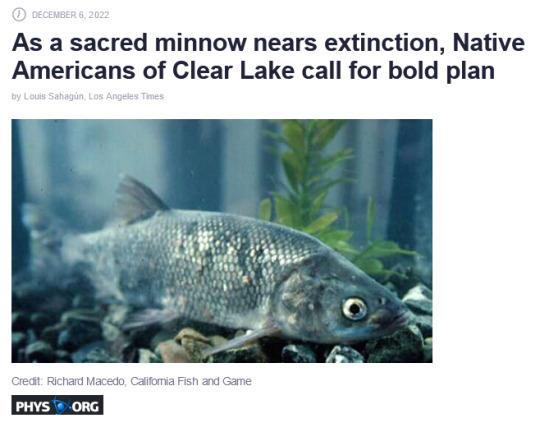
Spring runs of a large minnow numbering in the millions have nourished Pomo Indians since they first made their home alongside Northern California’s Clear Lake more than 400 generations ago. The Clear Lake hitch glinted like silver dollars as they headed up the lake’s tributaries to spawn, a reliable squirming crop of plenty, steeped in history [...].
In all that time, the hitch’s domain, about 110 miles northwest of Sacramento, had never suffered the degradation of recent years.
Now, with a growing sense of sorrow, if not anger, the Pomo Indian tribes of Clear Lake are watching the symbol of abundance and security they call chi dwindle into extinction.
---
On Monday [December 2022], they took the rare and drastic step of urging Interior Secretary Deb Haaland to use her emergency powers and invoke the federal Endangered Species Act on behalf of the Clear Lake hitch. “Bringing the chi back will require a bold plan of action devised by people with the power to move mountains,” said Ron Montez, tribal historic preservation officer for the Big Valley Band of Pomo Indians.
“I have almost zero confidence in state or federal officials to save the chi and our way of life,” Montez, 72, said. [...]
The Clear Lake hitch was designated as a threatened species under California’s Endangered Species Act in 2014. Since then, however, its numbers have fallen to near zero, according to recent surveys.
Some causes of the hitch’s decline, however, seem extraordinarily difficult to fix: prolonged drought, mercury contamination, gravel mining, an overtaxed water distribution system, pesticides and runoff from vineyards [...], and predatory nonnative game fish. [...]
---
The 2023 spring spawning season is crucial for the continued survival of the Clear Lake hitch, scientists say. That’s because the last observed successful spawning was in 2017. “Hitch have a six-year life span,” said Meg Townsend, an attorney with the Center for Biological Diversity. [...]
---
But until its fate is known for certain, Michael Fris, a field supervisor at the U.S. Fish and Wildlife Service, said his agency is unlikely to list the hitch on an emergency basis. [...] That kind of talk prompted the Center for Biological Diversity, together with the Big Valley Band of Pomo Indians, Robinson Rancheria Band of Pomo Indians, Scotts Valley Band of Pomo Indians and the Habematolel Pomo of Upper Lake to take their request for emergency listing to Haaland.
All involved agree that seeking intervention under the federal Endangered Species Act is an act of desperation. Only two species have been emergency-listed as federally endangered over the last 20 years: the Miami blue butterfly in 2011 and Nevada’s Dixie Valley toad earlier this year. [...]
---
The hitch is a 12-inch-long minnow found only in and around the oldest, largest and perhaps most polluted and wildfire-prone watershed in California. In 2020, the Lake County region was charred by six of the 20 largest wildfires in state history. [...]
It’s been the poor luck of the hitch to require adequate stream flows in February, March and April to trek from the lake to spawning beds at the same time agricultural interests need water to defrost their vineyards.
---
“An emergency listing would force people to consider alternatives to the way water is used in this region,” said Sarah Ryan, environmental director for the Big Valley Band of Pomo Indians.
Beyond water flows, the prospect of emergency-listing the hitch raises other economically significant issues connected to the lake’s food chain: Zooplankton are eaten by shad, crayfish and hitch, which are favored by monster catfish and largemouth bass.
Clear Lake entrepreneurs host dozens of professional bass tournaments each year that are supported by contestants from around the world.
The most popular lures in local tackle shops are hitch replicas that cost up to $180 each. Other lures are made to resemble juvenile hitch and sold under a slogan that some people feel mocks the creature’s cultural importance to Pomo people: “The All-American Trash Fish.”
Over at [C.O.], a sporting goods store on the southern end of the lake, old-timers still talk about how local kids had a tradition of “hitching,” beating hitch to death with baseball bats for fun as they ascended streams to spawn in spring.
They also grumble over the thought of new special protections for a nongame fish disrupting human pastimes for any reason [...].
"The reason our bass grow so big is that they love to eat hitch," mused [D.B.], owner of [C.O.]. "So, when customers ask me, 'Where can I catch the biggest bass of my life?' " he added, "I send them to places hitch hang out in."
---
That kind of banter and lore suggests that unless government agencies yield to Native American concerns, they are headed for a showdown of complicated and competing values.
“The way some people ridicule hitch makes me wonder what they think about the folks who eat them,” lamented Robert Geary, cultural resources director for the Habematolel Pomo of Upper Lake. [...]
---
At the heart of the matter is that Pomo people [...] did not consider their native attitudes and lifestyles to be an expendable price of living in America.
Yet, their modern history is told mostly through economic hardship, rip-offs, massacres and environmental destruction.
---
Headline, image, caption, and text by: Louis Sahagun of Los Angeles Times. “As a sacred minnow nears extinction, Native Americans of Clear Lake call for bold plan.” As published at Phys.org. 6 December 2022. [First paragraph in this post added by me.]
579 notes
·
View notes
Text
Categorized as “near threatened”.

The markhor was categorized as “near threatened” in 2014 and is on the International Union for Conservation of Nature Red List of Threatened Species, and has been included in Appendix I to the Convention on International Trade in Endangered Species of Wild Fauna and Flora since 1992.
#iucn red list#International Union for Conservation of Nature Red List of Threatened Species#Appendix I#Convention on International Trade in Endangered Species of Wild Fauna and Flora#near threatened#capra falconeri#markhor conservation#conservation efforts#markhor#straight horned markhor#bukharan markhor
0 notes
Text
Am I a little bit late for some of you? I might be. But anyways. Here's what went right around the world this past week :)
Youth climate activists won a huge climate lawsuit
Sixteens youths (aged five to 22) from Montana, US, have emerged victorious after suing state officials for violating their right to a clean environment.
In their lawsuit, they argued that Montana's fossil fuel policies contributed to climate change, which harms their physical and mental health. Montana is a major coal producer, with large oil and gas reserves. The state has rebuffed these claims, saying that their emissions were insignificant on a global scale.
Judge Kathy Seely, in a 103-page ruling, set a legal precedent for young people’s rights to a safe climate by finding in their favour. “Every additional tonne of GHG [greenhouse gas] emissions exacerbates plaintiffs’ injuries and risks locking in irreversible climate injuries".
This win marks the very first time a US court has ruled against a government for a violation of constitutional rights based on climate change. It will now be up to Montana lawmakers to bring state policies in line.
“As fires rage in the west, fueled by fossil fuel pollution, today’s ruling in Montana is a gamechanger that marks a turning point in this generation’s efforts to save the planet from the devastating effects of human-caused climate chaos.” - Julia Olson, executive director of nonprofit law firm, Our Children’s Trust, which represented the youths in this case.
Number of Mexicans living in poverty fell by millions
Thanks to a new minimum wage boost and increases to pensions, the number of Mexicans living in poverty fell by 8.9 million between 2020-2022, according to new data published by the country’s social development agency, Coneval.
Coneval’s statistics suggest that the number of people living in extreme poverty also fell – from 10.8 million in 2020 to 9.1 million last year – although that figure is still up from a pre-Covid 8.7 million recorded in 2018.
There is still a long way to go, and some critics do claim that during the current president, López Obrador's presidency has been characterized by austerity.
An organised crime group trafficking endangered species has been jailed
The Wildlife Justice Commission (WJC), a small European wildlife charity, is apparently busting kingpins behind as much as half of the world's illegal trade in pangolin scales. The traffickers began six-year jail sentences a few weeks ago.
The wildlife charity went undercover to expose three Vietnamese and one Guinean national, members of an organised crime group trafficking body parts of endangered species including rhinos.
They were arrested in May 2022, following a four-year investigation by the WJC, and were accused of trafficking 7.1 tonnes of pangolin scales, as well as 850kg of ivory. Last month they pleaded guilty to smuggling and were jailed for six years.
All eight species of pangolin are listed as threatened animals, four critically endangered - they are protected by international law.
“There has not been a reported seizure of pangolin scales in Asia originating from Africa in more than 550 days,” said Steve Carmody, WJC’s director of programmes. “There is no clearer example of the importance of disrupting organised crime networks.”
AI gave conservationists a breakthrough
The use of AI-controlled microphones and cameras seems set to revolutionise
biodiversity monitoring in the UK following groundbreaking work by researchers at the Zoological Society of London (ZSL). They used the tech to record and analyse 3,000 hours of wildlife audio captured by monitors located near London railway lines.
The computers detected dozens of bird species, foxes, deer, bats and hedgehogs, and mapped their locations.
It’s hoped the innovation will help improve conservation and habitat management on Network Rail land.
This year is best ever for UK renewable energy installations
This years looks to be the best year so far for UK renewable energy installations, with record numbers of households fitting solar panels and heat pumps.
2023 marks the first time solar panel installations have topped an average of 20,000 a month, as homeowners look to harvest energy from the sun amid rising utility bills.
Read the full story here.
The UK’s Tree of the Year shortlist was revealed
The Woodland Trust has announced the shortlist for its annual celebration of some of the UK’s most treasured ancient trees, and for 2023 the spotlight is on the urban landscape.
“Ancient trees in towns and cities are vital for the health of nature, people and planet,” said the charity’s lead campaigner Naomi Tilley. “They give thousands of urban wildlife species essential life support, boost the UK’s biodiversity and bring countless health and wellbeing benefits to communities.”
Article published August 17, 2023
Thank you so much for reading! Let me know what interested you, and if there's any specific topic you'd like me to dig into, my DM's are always open :)
Much love!
#climate change#climate#hope#good news#more to come#climate emergency#news#climate justice#hopeful#positive news
112 notes
·
View notes
Text

A Male Saiga Antelope in Russia's Black Land National Park. These highly social antelope live in herds. Photograph By Valeriy Malee/Nature Picture Library
This Floppy-Nosed Antelope Was Nearly Gone. 20 Years Later, It’s Thriving.
Less than a decade ago, more than half of the world’s saiga antelope were lost to a mysterious disease. Its comeback is a rare and phenomenal conservation success.
— By Jason Bittel | December 14, 2023
Just two decades ago, it seemed as if we might need to write a eulogy for the saiga antelope.
Cut down by widespread poaching and waves of disease, by 2003, just 6 percent of the floppy-nosed ungulates remained in Kazakhstan, Mongolia, Russia, and Uzbekistan.
But today, scientists are rejoicing at the saiga’s unlikely rebound.
There are now 1.9 million saiga antelope across Eurasia, according to the most recent estimates released this week. So many saiga, in fact, that the International Union for Conservation of Nature is upgrading the Red List status for the species from critically endangered to near threatened.
“There's a lot of conservation doom and gloom, and there isn't very much attention paid to conservation successes,” says E.J. Milner-Gulland, a conservation scientist at the University of Oxford and co-founder of the U.K-based Saiga Conservation Alliance. “It’s quite a vindication of 20 years of hard work by lots of people.”
To get a sense of just how far this species has come, in 2015, more than half of the worldwide population of saiga antelope were lost to a mysterious blood disease.
“This is phenomenal news,” says Joel Berger, an ecologist at Colorado State University and a senior scientist at the Wildlife Conservation Society, in an email.
“At a time when so many species and populations are in deep swan dives, to witness the recovery of saiga—a species deserving of more recognition in its own right—is something we all need to celebrate,” he says.
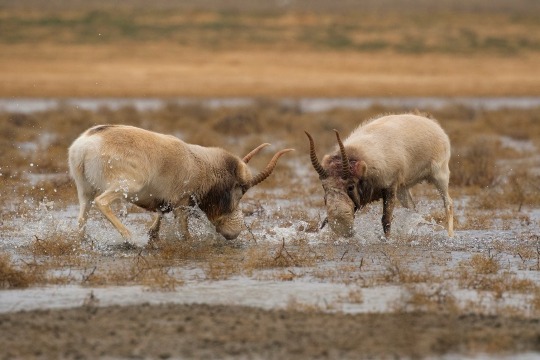
Male Saiga Antelope Battle in Black Lands National Park. Males and their horns are a specific target of poachers. Photograph By Valeriy Malee/Nature Picture Library
The Saiga’s Downward Spiral
Those who have been paying attention to the saiga’s saga know that it’s been a wild ride.
“Twenty years ago, it had the fastest increase in threat status of any mammal,” says Milner-Gulland. “The population had plummeted by more than 90 percent over a really short time of a few years, so it went straight in at critically endangered.”
As for what happened, Milner-Gulland explains that the saiga’s downfall can be attributed to several factors. For starters, saiga horn has great value in China, Singapore, Vietnam, and Malaysia as a component in traditional medicine. And this demand, coupled with the breakup of the Soviet Union, led to a dramatic rise in hunting.
It’s a Symbol of the Wild Steppe, of Independence and Freedom.
— E.J. Milner-Gulland, Conservation Scientist at the University of Oxford
“The economies of these countries basically collapsed,” she says. “And they were living in very harsh conditions on the steppe. So they turned to poaching.”
Fencing along the border between Kazakhstan and Uzbekistan also put a barrier in the middle of the saiga’s migratory route, while infrastructure development cut into saiga habitat. Finally, an unknown trigger turned a naturally occurring microbe in the saiga’s characteristic nose into a virulent pathogen, leading to the mass die-offs.
It’s for all these reasons that the IUCN has chosen not to de-list the saiga completely.
“The near threatened category is right for the saiga, because we know that at any time, we could just get large numbers of them dropping dead again,” says Milner-Gulland. “They are very vulnerable.”
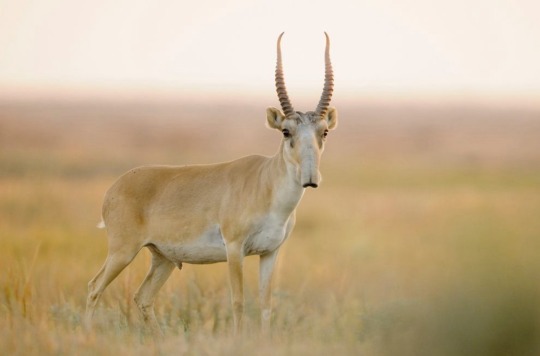
A Path to Recovery
Just as the threats to the saiga were multi-faceted, so too have been the efforts to protect the species, which are important seed dispersers and grazers that contribute to plant biodiversity.
For instance, an international collaboration between countries where saigas roam, countries that traditionally consume saiga products, and other stakeholder nations, including the United States, led to a memorandum of understanding in 2006 to conserve the species, restore its habitat, and restrict harvest to a sustainable level.
For its part, Kazakhstan’s government focused on stronger anti-poaching measures, including law enforcement to prevent saiga hunting. The Saiga Conservation Alliance supplied financing for gasoline, uniforms, motorbikes, and shelters for those rangers, who live in the harsh, windswept grasslands. Customs agents also improved detection of saiga products leaving the country as part of the illicit wildlife trade. Lastly, the country designated multiple protected areas totaling more than 12 million acres of saiga antelope habitat.
Now that economic conditions have leveled out and local people don’t have to choose between their own survival and saving saiga, there has also been a dramatic shift in support for the species.
“The thing about saiga is the local people really love it,” says Milner-Gulland. “It’s a symbol of the wild steppe, of independence and freedom.”
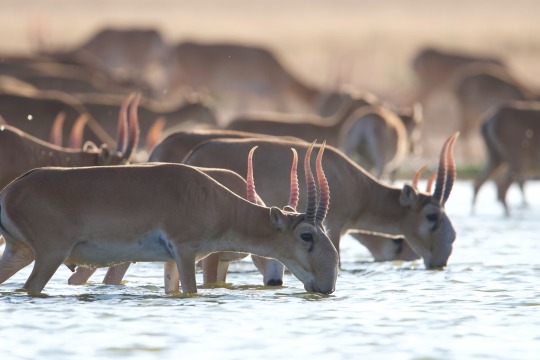
Saiga (Drinking on Southern Russia's Astrakhan Steppe) can migrate up to 600 miles over summer and winter. Photograph By Valeriy Malee/Nature Picture Library
#Animals 🦓 🦒 🐘#Floppy Nosed Antelope#Kazakhstan 🇰🇿 | Mongolia 🇲🇳 | Russia 🇷🇺 | Uzbekistan 🇺🇿#University of Oxford#Saiga Antelope#China 🇨🇳 | Singapore 🇸🇬 | Vietnam 🇻🇳 | Malaysia 🇲🇾#E.J. Milner-Gulland | Conservation Scientist | University of Oxford
41 notes
·
View notes
Note
jaguar!
Oo, fun.

Jaguars are actually the cat with the strongest bite relative to their size, strong enough to crush the animal's skull that they're hunting without much effort. Even scarier, they choose to just kill and eat caiman because they're abundant in their ecosystem. You know, this thing.

Because they like to snack on caiman, it would be obvious that they're not adverted to water. In fact, they love it and use it often to cool off. They like it more than tigers, who are often known to also hang out in water sources.

'Black panthers' are actually just a jaguar with melanism. They're not a separate species of big cat, though it's commonly mistaken. Leopards with melanism are also called a black panther. Again, it's still just a different coat pattern mutation.

Jaguars are one of the 4 cats that can truly roar. Others, like cheetahs cannot do this because the hyoid bone is completely ossified. With jaguars, leopards, lions and tigers, their epihyoideum is stretchy and allows them to roar, though it revokes their ability to purr. (whereas it's the other way around in other cats)
They're also near threatened, very close to being on the endangered species list because of habitat destruction and poaching.
Hope this was as fun for you as it is for me! Images have links to their sources.
40 notes
·
View notes
Text
Eofringillirostrum vs Heliothraupis
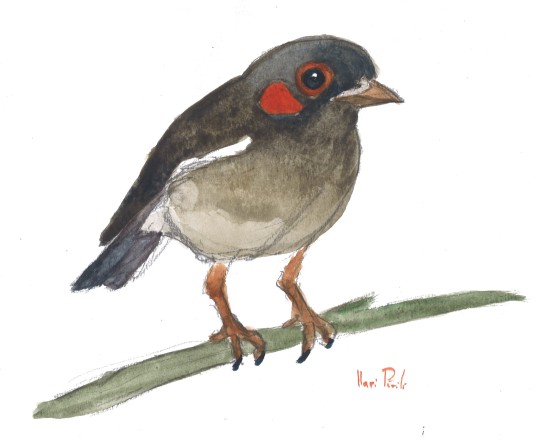
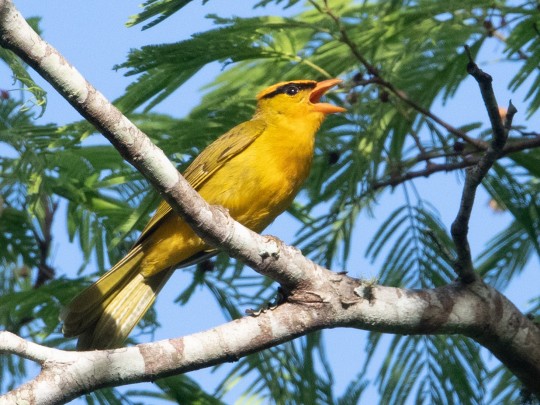
Factfiles:
Eofringillirostrum boudreauxi, E. parvulum

Artwork by @otussketching, written by @zygodactylus
Name Meaning: Dawn Finch-Beak (Boudreaux’s or Small)
Time: 54 to 48 million years ago, in the Ypresian of the Eocene
Location: Sandwich Beds, Fossil Butte Member, Green River Formation, Wyoming; and the Messel Formation near Darmstadt, Germany
Today, over half of the birds known in the world are passerines, or “perching birds”. Unfortunately, these birds on average are small and delicate, leading to their not having the most robust fossil record compared to other birds. However, the fossils of passerines we do have tell us an interesting story about their evolution. Eofringillirostrum, despite being a very early member of the total-passeriform group (ie, it isn’t a true passerine, but close), shows how many of the traits we see in modern representatives occurred fairly early on in their evolution. Eofringillirostrum had a finch-like beak, similar to living species, that would have been helpful in eating small hard seeds - a niche not easily exploited. While we often think of birds as “seed-eaters”, this is not common and only exploitable by certain species - and, apparently, some early passerine relatives like Eofringillirostrum. This indicates that different early relatives of passerines were already doing very similar ecological jobs to their living relatives, even while many other bird types were exploiting passerine-like niches (such as the many types of stem-mouse birds that lived at the time). Both the Messel Pit and the Fossil Butte environments were tropical forests, emerging right after the Paleocene-Eocene Thermal Maximum; both were associated with fossil lakes, which allowed for rapid preservation of a variety of early animals that show how “modern” life first diversified in the Paleogene period. As such, Eofringillirostrum just has too many neighbors to list - including so many kinds of birds its a little overwhelming. Eofringillirostrum, in this environment, would have been one of many different species of birds, and weirdly modern looking among them!
Heliothraupis oneilli

Photograph by John C. Mittermeier, written by @zygodactylus
Name Meaning: O’Neill’s Tanager of the Sun God Inti
Time: Unknown to the present, Holocene, Quaternary
Location: Western Bolivia and Southern Peru, South America
Rarely do we get to talk about a newly discovered living species of bird, but this is one of those excellent times! This bird, a bright yellow tanager with a distinctive black stripe across its eye, was found in the Neotropics - specifically in the Yungas region. Given that Latin America has the largest number of bird species in the world, it makes a certain amount of sense that we may have missed some! First spotted in the nineties, it was properly identified and described over the course of the 2010s. The distinctive appearance of this tanager lead to it being nicknamed the “Kill Bill Tanager”, in reference to its similarity to Uma Thurman’s yellow jumpsuit outfit. Distinct in appearance and population from other tanagers, it was deemed not only a separate species, but an entirely separate genus. It is migratory, breeding in the northern Machariapo Valley and going down to the eastern Andes for the nonbreeding season. It lives in deciduous forests, and breeds in bamboo grasses. It is a loud and vocal bird, making distinctive songs and choruses that happen long after the dawn chorus of most other birds. As it lives in a fairly isolated region of these countries, its habitat is not particularly threatened at this time.
DMM Round One Masterpost
#dmm#dinosaur march madness#dinosaurs#birds#dmm round one#dmm rising stars#birblr#palaeoblr#paleontology#bracket#march madness#polls#eofringillirostrum#heliothraupis
161 notes
·
View notes